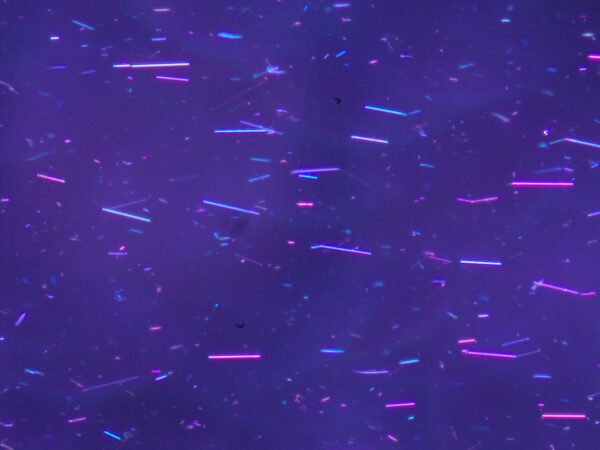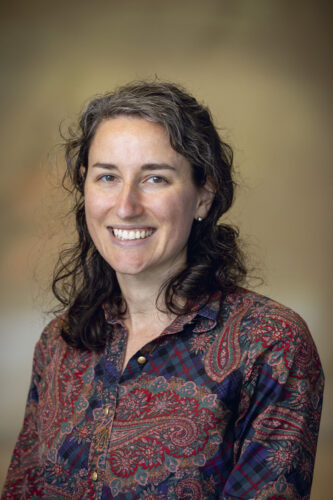Listen to the story below:
Taylor Teitsworth stared into the microscope in front of her thinking: No one has ever done this before, I’m the first one.
She was looking at a nanowire made of silicon, thousands of times thinner than a human hair, producing just over a volt of electricity. It was a long way from her desired destination, but this gave her a sneak peek into the future.
“It’s exciting wondering how your science will get used someday — hopefully for good things,” she says with a laugh.

An optical microscope image of nanowires floating in solution. The nanowires scatter different colors depending on their size and orientation with respect to the light. (photo by Taylor Teitsworth)
At the time, the UNC-Chapel Hill postdoctoral researcher was working as a chemistry PhD student in Jim Cahoon’s Lab, which focuses on the nanotechnology and solar energy fields. That single volt of electricity is a critical step in developing a Particle Suspension Reactor (PSR), a system used to split water into hydrogen and oxygen.
When used for electricity, hydrogen’s only byproducts are heat and water, meaning it doesn’t harm the environment. But finding a natural source or renewable method to produce it can be tricky.
By using a silicon nanowire, Teitsworth and Cahoon created a PSR that can absorb more sunlight than previous examples, opening the door to better methods for obtaining hydrogen fuel — a clean, renewable energy source — and liquid fuels.
Liquid fuels generate energy and take the shape of their container. They are easy to control and transport, require less space for storage, and produce more energy than solid fuels like coal and wood. But they are expensive and can be extremely volatile. The most common example is gasoline — a resource that is high in demand, limited in supply, and costly for the environment.
That’s where Teitsworth and Cahoon come in. The chemists are developing methods to harness solar energy and create liquid fuels as the world races to find more sustainable, less harmful sources of power.
Solving the solar conundrum
Alternative energy sources are a key step in reducing net carbon emissions, one of the biggest contributors to climate change. The prospect of creating new energy sector jobs and energy independence has added excitement to this field.
Despite the endless amount of energy supplied by our sun, it’s difficult to harness. Solar panels don’t create as much energy during cloudy days or at night, often when the most amount of energy is needed. As a result, solar power requires an effective method for storing the energy it creates.

Taylor Teitsworth (photo by Megan Mendenhall)
Teitsworth and Cahoon believe solar energy could be used to create hydrogen or liquid-based fuels, requiring fewer rare materials than other energy solutions like batteries. Sunlight is an ideal way to provide energy for what can be a challenging production process: Creating hydrogen from water requires electricity, and if that electricity isn’t generated in a renewable way, the hydrogen that forms isn’t sustainable.
In the search for clean hydrogen, PSRs have emerged as a favorable solution.
A PSR is a reactor made up of particles suspended or mixed in a liquid, like sand floating in a glass of water. When combined with sunlight, they cause a chemical reaction — most commonly water splitting.
But PSRs have their own drawbacks. Previous versions only absorbed small portions of visible light — which is mostly what the sun produces — so they’d often fail to utilize large amounts of the potential energy.
Teitsworth and Cahoon sought to make a better PSR, one more efficient at harnessing the full spectrum of the sun’s energy. They looked to one of the best collectors of solar energy on the market — the solar panel — and one of its key materials: silicon.
Silicon is stable, abundant, and excellent at absorbing a large range of light wavelengths, making it the ideal particle for use in a PSR. But a single silicon solar cell — a unit or particle that can create energy when illuminated by light — does not produce enough voltage to split water on its own.
Using nanotechnology previously developed in Cahoon’s lab, Teitsworth synthesized a wire containing up to 40 silicon solar cells. And the results have been first-of-their-kind.
Expanding the bounds of science
The technology has been an enormous success for creating hydrogen, and its potential expands far beyond that. Other members within the Center for Hybrid Approaches in Solar Energy to Liquid Fuels at UNC-Chapel Hill are learning how these PSRs might be used to generate liquid carbon fuels.
“The nice thing about this system is that it’s very customizable,” Teitsworth says. “We designed these reactors to split water because it was a demonstration we felt we could do, but we could change the design to do many other things.”
Liquid carbon fuels created by solar energy provide a carbon-neutral alternative to coal, oil, and natural gas. But there is no singular solution to alternative energy sources, Cahoon stresses, so any step forward has massive potential.
“Consumer vehicles will go the battery route. But if you think about something that requires large, heavy equipment, batteries don’t make sense,” he says. “They would have to be big, and you couldn’t charge them fast enough. In that example, we might need to use something like hydrogen. We will need different technologies to fit different needs.”
No matter where the project goes from here, Cahoon believes the importance lies in expanding the bounds of science, something he’s always been interested in.
“I’m really invested in the long-term development of the science of these particles, continuing to make them better and learn more about them, and pushing forward the technology at a fundamental level,” he says.
As for Teitsworth, she’s trained a new set of PhD students in Cahoon’s lab to continue her work with silicon solar cells and has moved on to a new project within CHASE, focusing on using traditional solar panels to convert carbon dioxide into liquid fuels.


